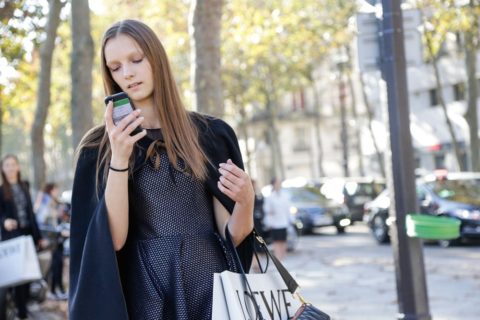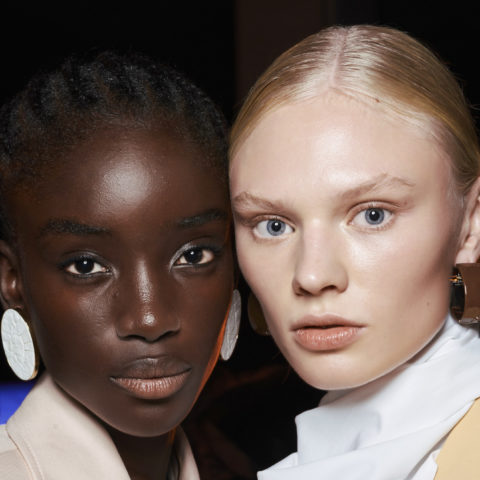Your online beauty reviews might be making the world a better place

Imagine shopping for beauty products before the Internet existed. You’d be pacing the aisle of the drugstore, trying to decide which mascara deserves your money. What could you use to inform your purchase? There’s your own past experience with a product, but perhaps you wanted to try something new. Maybe you’d heard good (or bad) things via word of mouth from a friend, or maybe you’d opt for the same products your mother uses. Finally, there’s a brand’s ads in magazines or on TV–not the most unbiased source but certainly convincing at times.
One has to admit that making a beauty purchase based on the above influences isn’t the best plan, and is bound to result in wasted money at some point. What works for one woman won’t necessarily work for another, and of course ads can be misleading about a product’s efficacy.
Now let’s take a moment to breathe a sigh of relief that this scenario is no longer the case. It’s not unusual these days to see someone perusing the shelves at their local drugstore or beauty store with a smartphone in hand, cross-checking potential purchases with online reviews. Suddenly, with so much information readily available at our fingertips, the process of shopping for the beauty products we really want has never been easier. The accessibility and sheer wealth of information available online has created a new breed of beauty consumers.
The beauty consumers of 2015 are smart and demanding. They are Internet-savvy and therefore more educated about the options available to them, whether they want to know the best ingredients for their skin type or where to find a cheaper version of a product. They are also incredibly vocal about their wants and needs, from blogging to using social media to connect with brands, sharing their opinions on everything from customer service to the lack of shades available. Beauty consumers are now also more likely to trust online reviews rather than a brand’s advertisements and marketing. In the past, the average woman may have trusted an ad for a product that promises smaller pores; now, she’s more likely to seek out visual proof of those smaller pores in online reviews before purchasing.
So many women have at least one or two favourite beauty blogs that they read regularly, while others follow beauty vloggers on YouTube. At the very least, it’s easy to do a quick Google search on a product that you’re curious about and, within minutes, be able to find out the ingredients, the scent and feel, how it looks or works on other people, where to buy it or a similar product, and for how much.
Samantha Johnston, a beauty writer in Toronto, agrees: “I think our generation has far more options and an easier route to the answers to any questions they have about products.” If a quick Google search on one’s smartphone reveals that a product has only one star and multiple negative reviews on a beauty website such as MakeupAlley, that product is quickly getting placed back on the shelf. Websites such as Paula’s Choice are particularly instrumental in informing women’s beauty purchases, with their Beautypedia reviews that have a strong focus on the quality and efficacy of ingredients and packaging.
Consumers nowadays aren’t shy about using their own voices online, in addition to reading others’ reviews. Not only are average women more likely to leave comprehensive reviews of products online in order to aid fellow shoppers, but they also flock to social media to praise or criticize brands. As beauty writer Wendy Rose Gould says, “I would say we’re much more informed. Not only are companies held to a higher standard, the information is made so readily available by the Internet. If a company does wrong, the entire beauty world hears about it. As a whole, we’re much more informed and therefore more cautious with our purchase decisions.” Take for example the scandal that erupted earlier this year when the CEO and president of Revlon, Lorenzo Delpani, was the focus of a lawsuit that claimed Delpani made racist comments. Outrage quickly followed, with consumers (especially black women) rushing to Revlon’s Instagram account to vow a boycott of Revlon’s products.
As consumers become more educated about beauty, they also become more choosy. Suddenly, the average beauty consumer can prioritize their needs without worrying as much about being able to find a product within their budget. For some this means catering to their sensitive skin or even their personal moral code. Beauty writer and photography student Elizabeth Lim says, “I try my hardest to only buy from cruelty free beauty brands now for the sake of ethics.” She’s certainly not the only one. Other women are careful to avoid products that contain certain ingredients, such as parabens, fragrance, sulfates, and even gluten. And why not, considering how easy it is to find a product that checks all of your boxes with a simple Internet search.
Brands that neglect to offer cruelty-free products, a wide range of makeup shades to suit all skin tones, or options for sensitive skin are not only bound to lose out on business but also get called out for their failings on social media or blogs. In the past consumers didn’t have much recourse other than simply not purchasing the product, but now they can make their dissatisfaction very publicly known, thus influencing other consumers. Beauty writer Maricar Santos says, “I think it’s too risky for companies not to cater to our preferences. There are so many options out there in the beauty market. If a product doesn’t cater to our need, it’s really easy for us to move on to something else.” For example, women who were offended by the allegations against Revlon CEO Delpani have the option of giving their money to a multitude of black-owned beauty brands instead.
Beauty brands who want to reach contemporary consumers have had to adjust their marketing strategy somewhat (yes, beyond simply not insulting them). The modern, educated beauty consumer is much more likely to trust a blog or online review than an ad that they saw on TV. Beauty blogger Allison Marie says, “I would say we are way more informed, concerned, and influential than ever in the past because of the Internet and social media in general. That’s why beauty blogging got so huge. Gen X is more likely to believe a random stranger on the Internet [telling] them a product is good rather than the company itself.” Of course, it’s a requirement for all brands to have a strong social media presence, but they’ve quickly learned that it’s equally important to work with influential bloggers.
This has led to many brands collaborating with bloggers to promote their products, which in turn led to the FTC cracking down on bloggers who neglected to include the appropriate disclaimers in posts that were sponsored or featuring gifted products. Magazines (including online magazines) don’t require a disclaimer for reviewed products that were received for free, but small blogs do. Still, that doesn’t deter women from trusting their favorite bloggers and vloggers. Santos says, “I think our generation is more informed and choosier because we have access to a lot of bloggers who will give us very honest opinions about products. Back then, my mom only knew if a product was really good by word of mouth. Aside from that, she’d only have the makeup counter lady’s sales pitch to go by.” With or without a disclaimer, consumers often take online reviews at face value–perhaps because they see the bloggers as real people, or perhaps because many bloggers do include a good amount of negative reviews, such as Christine Mielke of Temptalia.
Teens in particular tend to be less aware of any bias; as Lim says, “I find a lot of people my age (17, 18) don’t really know or care for ingredients and stuff and get swept up in the hype of some products from YouTube.” Even with access to endless amounts of reviews and information online, it is up to the consumer to seek it out. If someone isn’t interested in educating themselves about products, they’re likely to be sucked in by advertising and marketing techniques in the same way as previous generations. As xoVain writer Cait Eileen says, “I know plenty of people here in the suburban Midwest that couldn’t care less about sexist advertising or cruelty free products because that’s just not something the overall culture encourages. The Internet has made it all possible though, so if there is a suburban Midwesterner that cares about something valid they can research and order products.” The point is, the power is readily available for beauty consumers. They just have to care enough to reach out and use it.
As for why this is important, it’s obviously a triumph anytime the average consumer is able to make the right purchase choice for themselves without being swayed by the marketing tricks of a large industry. But modern beauty consumers are having a bigger impact on the world than that.
Thanks to a greater demand for cruelty-free products (in a large part from beauty consumers, in addition to animal activists), both Canada and the U.S. are making strides towards banning cosmetic animal testing with the Cruelty-Free Cosmetics Act and the Humane Cosmetics Act, respectively.
Greater inclusivity is also being celebrated in the beauty world, from diverse women such as Lupita Nyong’o being the face of Lancome and transgender model Andreja Pejic landing a campaign with Make Up For Ever.
Modern beauty consumers are now using not just their dollars but their online voices to shape brands. They’re helping the beauty industry to not only create better products, but to be more ethical, more inclusive, and more responsible. By doing so, they’re forcing the world to change for the better, one lipstick at a time.







